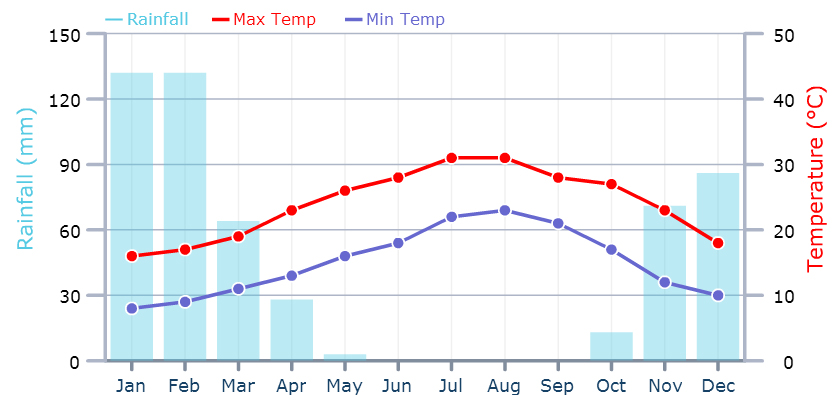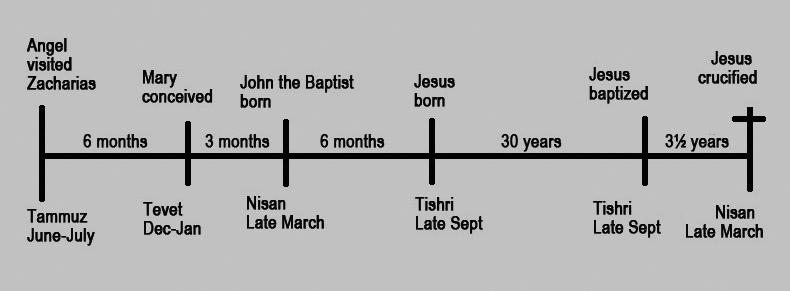When Was Jesus Born?
Q: When, or what season of the year, was Jesus Christ born?
A: This question has often been posed to me. But whenever it comes from a Branhamite, the question is often accompanied by a regurgitation of what Branham said, quotes from His sermons, just so to show that no matter what my answer, I was wrong. Such believers have a sense of pride to think and believe they know what they do not know.
Here is an example from one (M.W.) who disagrees with my teachings; he wrote:
In your message you state categorically that Christ was born in September. This view is close to the Catholic view than to the Message or the Bible and here is why:
1. Brother Branham said several times that he believed that Christ was born during the spring time in Palestine and that would put the time frame somewhere around April. This is also the time when sheep have their lambs and so it would not be surprising for the Lamb of God to be born around that time. [Note: Does M.W. know that Branham believed and taught that Jesus Christ preached for 3½ years, and died at the age of 33½? How does it add up to 33½ years, if Christ was born in April and died in April? Foolishness. And, Anti-Branham preachers will accuse Branham as a liar because he made such statement not once or twice but several times.]
2. The other reason is that the Bible shows that shepherds were with the sheep out in the fields where the Angels appeared to them announcing the birth of the Lord Jesus Christ. They would never spend the night out in the open in late autumn or winter which September represents. This points to a warmer time of the birth of our Lord.
3. The Romans had just been conducting a census during the time of the birth of the Lord and this is Why Joseph had to return with his wife Mary to Bethlehem. The Romans were wise people and they did not send out their soldiers to conduct a census in winter but in warmer months. This is a historic fact. This also points away from September and towards March-April.
4. Josephs wife was nearing full term of pregnancy and he would never undertake a risky journey in winter because of the risks.
5. I said the view is closer to the Catholic teaching because September is closer to the Catholic December 25 than April.
You can still stick to September if you wish in order to maintain your message but remember it is at variance with Bible and message teaching.
Interestingly, this believer’s arguments are partly sound, but he shot his own foot because he did not know the climates in Palestine are different from those in America.
There are many believers like him, foolishly quoting Branham without realizing that Branham might just be wrong in using the lambing season (Spring) of America for that in Palestine. And it is a misleading notion to stress that sheep have their lambs only in Spring, is to say that there are no lamb born in any other seasons of the year, in countries with different seasons. Let us also not forget that there are different types of sheep. Consider the "fat tail" sheep in the Arabic and Asiatic countries which lambing seasons are often in the autumn, and even winter, unlike those sheep in western countries.
The general periods of American’s four seasons are:
Spring - March Equinox to June Solstice;
Summer - June Solstice to September Equinox;
Autumn (Fall) - September Equinox to December Solstice; and,
Winter - December Solstice to March Equinox.The four seasons in Palestine are different. During the Greco-Roman period, the Jews divided the year into four seasons by using the original Hebrew names of the months in which each season began:
Spring - 15 Shevat - 1 Tammuz
(January-June)
Summer - 1 Tammuz - 1 Tishrei
(June-September)
Autumn (Fall) - 1 Tishrei - 25 Kislev
(September-November)
Winter - 25 Kislev - 15 Shevat
(November-January)Now, the annual temperature range around the vicinity of Jerusalem and Bethlehem is shown in this graph:

Winter, of course is the coldest period. As suggested by M.W., the sheep could not be out in the field in winter or even late autumn (see point 2 in his argument). That is perhaps true in America but in Palestine the season happens to be the beginning of autumn; the temperature is still warm, about 28°C (82°F) to 14°C (57°F). However, the temperature in the month of March-April is much colder, being early spring, 7°C (45°F) to 21°C (70°F).
Sept-Oct. climate: 28°C (82°F) - 14°C (57°F) [Av.15°C]
Mar-Apr. climate: 7°C (45°F) - 21°C (70°F) [Av. 8.5°C]Therefore the months of November to April, being cold months (in Palestine, not America) are unlikely months for sheep to be out in the field. For the Roman government to conduct a census throughout their empire during those cold months would be self-defeating; citizens would find it difficult to travel to their city or town of birth to be registered. That rules out Joseph and his pregnant wife Mary, making a trip from Nazareth to Bethlehem since a census would not have been decreed. Therefore, the notion that Jesus was born in December or April is a lie. One is a Catholic teaching; the other, an idolatrous belief/trust. Both are at variance with the Sacred Scripture; both are held by make-believers of the Bible.
The only logical time of Jesus’ birth must be in the late Summer or early Fall. Biblical accounts point to the Fall of the year as the time of Jesus’ birth.
Briefly, from the Biblical account:
Zacharias was a priest of the course of Abia (Luk.1:5). One day Angel Gabriel appeared to him while he was serving in the Temple, to tell him that his wife Elizabeth would have a son (Luk.1:8-17). Jewish writings tell us that the service of the Abia (Abijah) division of priests was scheduled for the last two weeks of the Hebrew month Tammuz, which corresponds to June-July of the Gregorian calendar.
In the sixth month of Elizabeth’s pregnancy with John the Baptist, Mary conceived Jesus (Luk.1:24-33); the month being Tevet (December-January). Three months later, in the month of Nisan (late March), about the time of the Feast of the Passover, John the Baptist was born. [Note: The Jews have long held to the tradition that the prophet Elijah will return at Passover (cf. Mal.4:5-6; Luk.1:17). Incidentally, John the Baptist was beheaded in the week before Passover, a year before Christ was crucified (Mat.14:1-12; Joh.6:1-14).] Adding another six months (the difference in age between John and Jesus), brings us to the seventh month, Tishrei or Tishri (September-October), when Jesus was likely born end of September. The Jews celebrate the Feast of Tabernacles in the month of Tishri, from 15th to 22nd day. How apt that Jesus would say to the Father, “…a body hast thou prepared me” (Heb.10:5); a revelation revealed to Paul concerning the prophetic utterance of King David in his praise of Yahweh in the 40th Psalm.
Consider the day Jesus was born and the day He was baptized. As a child Jesus grew “and waxed strong in spirit, and was in the deserts till the day of his shewing unto Israel” (Luk.1:80 cf. 2:52). That “day of his shewing unto Israel” was when He was “about thirty year of age” (Luk.3:23), after “being baptized, and praying, the heaven was opened, And the Holy Ghost descended in a bodily shape like a dove upon him, and a voice came from heaven, which said, Thou art my beloved Son; in thee I am well pleased” (Luk.3:21-22). Yahweh suddenly came into His temple and tabernacled in the flesh of His own Son (Mal.3:1; Joh.14:10; Col.2:9). How timely and fulfilling were His birth and incarnation – on the very same week of the Feast of Tabernacles! The Feast of Tabernacles is a feast of thanksgiving, the most joyous of all the Jewish feasts. The significance of the feast will only be fully realized when our Lord Jesus returns to tabernacle among men and reign for a thousand years, during the Age of Regeneration.
Those who insist that Jesus was born in April and died in April believe He only ministered three years. (Those who are uncertain, believe it could be two years, or even four.) The Gospel of John shows that Jesus ministered longer than that. Apostle John recorded a total of four Passovers (Joh.2:13; 5:1; 6:4; 13:1) in the life of Christ, after His baptism; His death being in the last of the four. The time and events between the baptism of Jesus and the first mentioned Passover are abridged in John’s Gospel, chapters 1 to 2.
Apostle John did not record about the Spirit leading Jesus into the wilderness to be tested of the devil after His baptism (Mat.4:1). After the forty days of temptation Jesus returned to Nazareth to recuperate. It is not known how long He remained in Nazareth before He went out to Bethabara, beyond Jordan, where He was baptized; to where John the Baptist was preaching and baptizing. It was during one of the visits that the Baptist saw Jesus and declared, “Behold the Lamb of God, which taketh away the sin of the world” (Joh.1:29).
The following two days Jesus called His first four disciples (Joh.1:35-51).
Then on the third day, Jesus and His mother went to Cana for a wedding (Joh.2:1-11). No record was given on the number of days for the wedding feast or the length of time that Jesus and His mother remain in Cana after the wedding, before they returned to their home in Nazareth. During that late cold winter period, December to early March, Jesus and His immediate family most likely remained in Nazareth; there Jesus spent time ministering.
The Apostle John then wrote (Joh.2:12): “After this – the period of events detailed in John 1:33, 43 and 2:1 concerning the movement of Jesus after John the Baptist declared Him as the Lamb of God (Joh.1:29) – he went down to Capernaum, he, and his mother, and his brethren, and his disciples: and they continued there not many days”. Jesus, his mother, brothers and the four disciples then moved out of Nazareth, where He had been raised, to stay in Capernaum. They were there “not many days” – that is, less than many but more than few – perhaps because the Passover was drawing near.
Jesus was raised in Nazareth, but the people of the city violently rejected Him (Luk.4:16-30). After Jesus heard that John the Baptist was cast into prison (Mat.4:12-13), He left Nazareth to live in Capernaum, which became “his own city” (Luk.4:31; Mat.9:1).
All in, the whole period could not have taken just a few weeks. It required a few months; from September to April. And so, there is no doubt our Lord Jesus ministered for about three and a half years after His baptism in late September, the time of the Feast of Tabernacles, the same period of His birth, thirty years earlier. Jesus was crucified in the month of April, on Passover day at the age of thirty-three and a half years old.
Z Z Z Z Z Z Z
